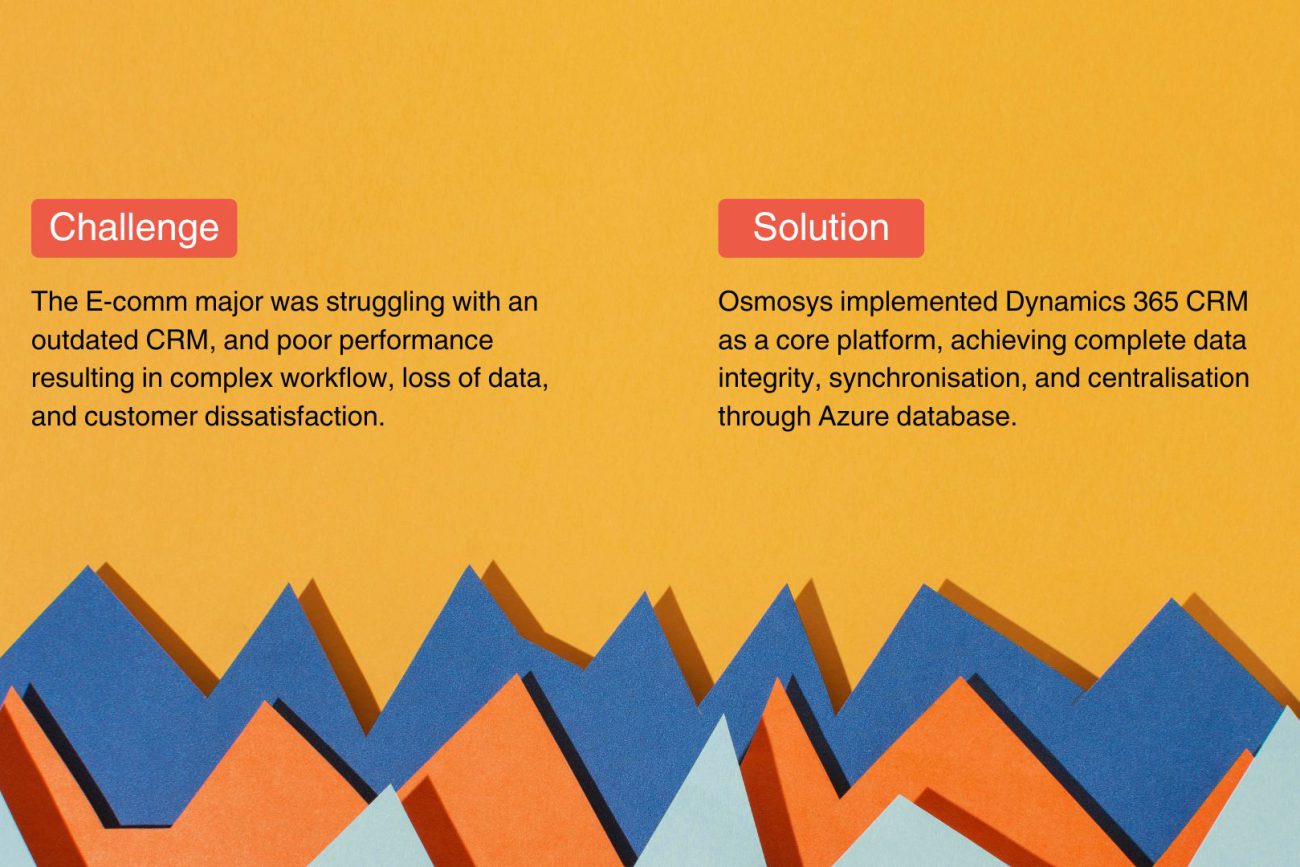Today, most e-commerce companies face unprecedented challenges in managing their technological infrastructure. This Microsoft Dynamics 365 case study by Osmosys examines how a major player in the B2C retail market successfully navigated a complex digital transformation journey.
Our client, a leading e-commerce company, found itself grappling with an intricate web of over 50 disparate software systems. This fragmentation led to significant operational inefficiencies, data inconsistencies, and hindered the company’s ability to adapt to market changes.

Recognising the need for change, the company embarked on an ambitious project to streamline its operations and consolidate its technology stack. At the heart of this transformation was the implementation of D365, supported by strategic integrations with Azure services.
Table of Contents
The Challenge: Navigating a Complex Digital Landscape
As the e-commerce company expanded its operations, it encountered a series of interconnected challenges that threatened to impede its growth and operational efficiency:
- Fragmented Software Ecosystem: Over 50 disparate systems created a complex technological environment, making management and upgrades difficult.
- Tight System Coupling: Interdependencies between systems hindered flexibility and adaptability.
- Data Inconsistencies: Multiple systems led to inaccurate and inconsistent data across a vast SQL server, impeding effective decision-making.
- Legacy Architecture: Outdated design structures slowed system performance and limited scalability.
- Knowledge Gaps: Lack of comprehensive documentation resulted in a limited understanding of the entire system across the organisation.
- Operational Inefficiencies: Siloed processes and complex integrations led to productivity bottlenecks.
These challenges threatened the company’s competitive edge in the e-commerce sector, necessitating a comprehensive digital transformation to streamline operations, improve data integrity, and prepare for future growth.
The Solution: A Comprehensive Digital Overhaul
To address the specific challenges faced by the e-commerce company, we implemented a tailored solution:
- Tackling Fragmented Software Ecosystem: We consolidated the 50+ disparate systems by implementing Dynamics 365 as the central platform. This significantly reduced the complexity of the technological environment, making management and upgrades more straightforward.
- Resolving Tight System Coupling: By integrating the existing SQL database with D365 using Azure Function Apps and Azure Data Factory, we created a more flexible architecture. This allowed for easier modifications and replacements of individual components without affecting the entire system.
- Addressing Data Inconsistencies: We implemented two-way data synchronisation between SQL and Dataverse, along with comprehensive data cleansing and standardisation efforts. This ensured accurate and consistent data across all systems, enabling more effective decision-making.
- Modernising Legacy Architecture: The adoption of D365 and Azure services replaced outdated design structures with modern, scalable architecture. This significantly improved system performance and enhanced the company’s ability to scale operations efficiently.
- Bridging Knowledge Gaps: We implemented comprehensive documentation practices and conducted thorough knowledge transfer sessions. This ensured a broader understanding of the new system across the organisation, reducing reliance on a few key individuals.
- Improving Operational Efficiency: Business processes were analysed and optimised within CRM, breaking down silos and streamlining workflows. We also adopted the SCRUM methodology for agile development, ensuring continuous improvement based on user feedback.
To support these solutions, we leveraged key tools including Microsoft Dynamics 365, Azure Services, .NET Framework, and maintained SQL integration. We also implemented features such as a unified interface, two-way data synchronisation, optimised workflows, and CI/CD pipelines for smooth deployments.
This comprehensive approach not only addressed the immediate challenges but also positioned the company for improved efficiency, data integrity, and future scalability in the competitive e-commerce landscape.

Key Tools and Features
To power this transformation, we leveraged:
- Dynamics 365: The backbone of the entire operation, serving as the go-to platform for everything.
- Azure Services: We utilised Azure Function Apps and Azure Data Factory, bringing the power of the cloud to bear.
- .NET Framework: This enabled robust application development.
- SQL Integration: We maintained a connection with legacy database systems, keeping the old and new in perfect sync.
Key features of the new system included:
- Unified Interface: Dynamics 365 became the central platform, eliminating the need to juggle multiple systems.
- Two-way Data Synchronisation: Ensuring data consistency across all systems.
- Optimised Workflows: Business processes got a major overhaul, cutting through old inefficiencies.
- CI/CD Pipelines: These allowed for smooth sailing when launching new updates.
The Results
So, what happened when all these pieces fell into place? Let’s break it down:
- Productivity Skyrocketed: With streamlined processes, tasks that used to take days now wrap up in hours.
- Decision-Making Leveled Up: Consistent, reliable data meant leaders could make calls with confidence.
- Agility Became the Norm: Market shifts? No problem. The new system allowed for quick pivots.
- The Bottom Line Got a Boost: Fewer systems meant lower costs – music to any CFO’s ears.
- Customers Noticed the Difference: A seamless experience across all touchpoints? That’s how you win loyalty.
Keynotes
This journey taught us some invaluable lessons:
- Know Your Processes Inside Out: You can’t improve what you don’t understand.
- Listen to Your Users: They’re on the front lines – their feedback is gold.
- Clean Data is Happy Data: Invest time in data cleansing. Trust us, it pays off.
The Road Ahead
With these changes, our e-commerce client isn’t just keeping up with the market – they’re setting the pace. They’ve laid the groundwork for innovations we probably can’t even imagine yet.

Ready to Write Your Own Success Story?
If this tale of digital transformation has got you thinking about your own systems, you’re not alone. Why not take a closer look at your operations? There might be hidden opportunities for a game-changing overhaul.
Want to dive deeper? We’re always here to chat about the nuts and bolts of digital transformation. Let’s explore how your business could be the star of the next success story.


